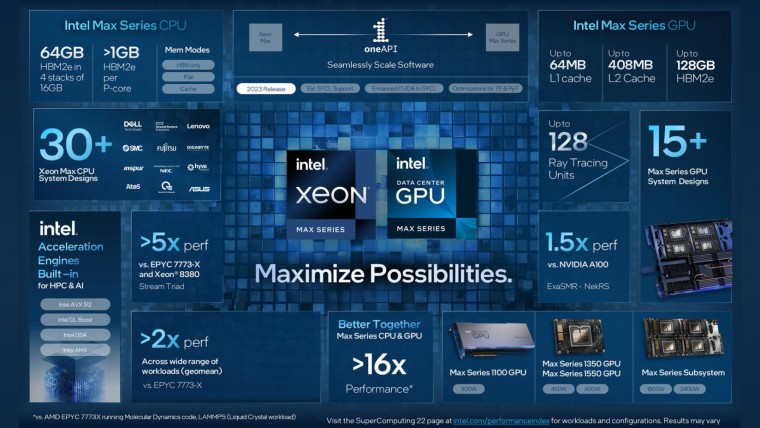
Intel has announced the arrival of its Intel Max Series product family with Intel Xeon CPU Max Series and Intel Data Center GPU Max Series. They come with the code-names Sapphire Rapids HBM and Ponte Vecchio, respectively.
They have been built for high-performance computing (HPC) and artificial intelligence (AI) ahead of Supercomputing '22 (SC22) in Dallas happening between November 14-17. The latest products come with the aim of powering the upcoming Aurora supercomputer at Argonne National Laboratory.
The Xeon Max CPU is "the first and only" x86-based processor that features high bandwidth memory. This enables it to enhance HPC workloads without requiring code changes. The Max Series GPU is the tech giant's highest density processor. It features 100 billion transistors in a 47-tile package with over 128 gigabytes (GB) of high bandwidth memory (HBM). The oneAPI open software ecosystem offers the programming environment for the products.

Corporate Vice President and General Manager, Intel Super Computer Group, Jeff McVeigh talked about the Intel Max Series product family, stating:
To ensure no HPC workload is left behind, we need a solution that maximizes bandwidth, maximizes compute, maximizes developer productivity and ultimately maximizes impact. The Intel Max Series product family brings high bandwidth memory to the broader market, along with oneAPI, making it easy to share code between CPUs and GPUs and solve the world’s biggest challenges faster.
The Xeon Max CPU delivers 56 performance cores constructed of four tiles and connected via embedded multi-die interconnect bridge (EMIB) technology, in a 350-watt envelope. Xeon Max CPUs feature 64GB of high bandwidth in-package memory along with PCI Express 5.0 and CXL1.1 I/O. Xeon Max CPUs will offer over a GB of high bandwidth memory (HBM) capacity per core.
Here are some of Intel's claims about performance:
- 68% less power usage than an AMD Milan-X cluster for the same HPCG performance
- AMX extensions boost AI performance and deliver 8x peak throughput over AVX-512 for INT8 with INT32 accumulation operations.2
- Provides flexibility to run in different HBM and DDR memory configurations.
- Workload benchmarks:
- Climate modeling: 2.4x faster than AMD Milan-X on MPAS-A using only HBM.
- Molecular dynamics: On DeePMD, 2.8x performance improvement against competing products with DDR memory.
Max Series GPUs offer over 128 Xe-HPC cores along with other features incorporating:
- 408MB of L2 cache – the highest in the industry – and 64MB of L1 cache to increase throughput and performance.
- The only HPC/AI GPU with native ray tracing acceleration, designed to speed scientific visualization and animation.
- Workload benchmarks:
- Finance: 2.4x performance gain over NVIDIA’s A100 on Riskfuel credit option pricing.
- Physics: 1.5x improvement over A100 for NekRS virtual reactor simulations.
Max Series GPUs will be available in several form factors depending on the needs and requirements of the customer:
- Max Series 1100 GPU: A 300-watt double-wide PCIe card with 56 Xe cores and 48GB of HBM2e memory. Multiple cards can be connected via Intel Xe Link bridges.
- Max Series 1350 GPU: A 450-watt OAM module with 112 Xe cores and 96GB of HBM.
- Max Series 1550 GPU: Intel’s maximum performance 600-watt OAM module with 128 Xe cores and 128GB of HBM.

Beyond individual cards and modules, Intel will deliver the Intel Data Center GPU Max Series subsystem with x4 GPU OAM carrier board and Intel Xe Link. It is to enable high-performance multi-GPU communication within the subsystem.
The two products will hit the markets in January next year. The tech giant will ship blades with Max Series GPUs to Argonne National Laboratory. The Xeon Max CPUs will go to Los Alamos National Laboratory, and Koyoto University, among others.




















4 Comments - Add comment